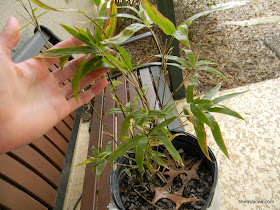| Bamboo leaves that are receiving adequate water are flat and open |
| While the leaves of the same type of bamboo (in this case, yellow groove running bamboo) getting insufficient water curl inward |
I received this email today:
We have had our bamboo in the ground for about 3 weeks now, Seabreeze and Vivax. I have the spray emitters I purchased from you on the 12 Seabreeze and have been watering the Vivax by hand. After reading the internet and your blog I am finding conflicting information on watering. In one of your recent posts it said water as much as possible during daylight hours. Another spot on your site I read 30 min twice daily when new.
Other places on the net vary from every other day to once a week after established. Due to our current schedule, I have been watering with the spray emitters for about an hour a day, sometimes longer in the afternoon and then a good soaking with the hose on the Vivax. I have mulched the plants with leaves and the soil remains damp until the next watering. I am seeing a lot of new growth on the current canes so I assume I am giving enough water.
My response:
Sorry for the confusing information. The bottom line with bamboo in FL is that it is almost impossible to give them too much water. If the bamboo are standing in water that doesn't drain away for more than two weeks, that would be a problem, but that isn't likely to happen in FL. It might happen if you lived in an area where soil drainage is poor with, for instance, pockets of heavy clay. In that case, over-watering would be a concern.
The post where I mentioned watering the bamboo as much as possible refers to recently transplanted large clumps of bamboo like the one pictured in that post. The watering you are doing to your smaller plants is perfectly adequate. The thing to understand with bamboo is that it likes water and sends out more shoots when grown in moist conditions.
That's not to say bamboo won't grow well with less water. It will, just not as vigorously. We tell people to water frequently in the beginning to both help the plants adjust to transplanting and also to encourage growth. After two or three years, your bamboos will have met or exceeded your initial size/height/width expectations. (For examples of bamboo growth, see the 'Before and After' pictures sent by our customers.) At that point you might want to back off watering. You can even stop irrigating completely after a couple years and the bamboo will still do just fine.
The thing to remember is you can slow down or increase the size of your clump by adjusting TWO THINGS: The amount of water the bamboo receives and the frequency of soil amendments in the form of fertilizer and/or top dressings of organic matter like leaves, grass clippings, compost, manure, etc.
More of both = More prolific growth.
Regarding the time of day to water, it is not important when you water. Do it whenever it is convenient for you. The main thing, when your plants are young, is to water them regularly. We recommend using a programmable timer but even if you rely on hand-watering, use the bamboo leaves as indicators of your watering needs. If you see leaves beginning to curl, then you know they need more water. Turn on the sprinklers, the leaves will uncurl and the bamboos will be happy.
| It doesn't matter if you use overhead sprinkers, spot spitters or hand-water, the important thing is to water your newly transplanted and young plants regularly |






